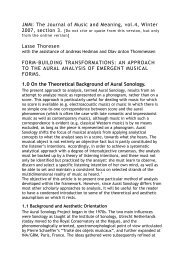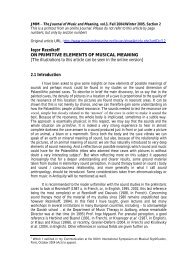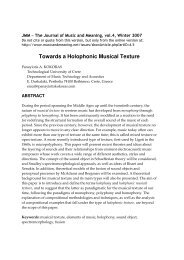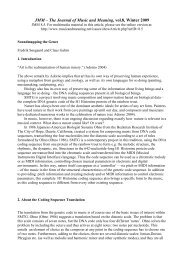Tenzer, Michael - Journal of Music and Meaning
Tenzer, Michael - Journal of Music and Meaning
Tenzer, Michael - Journal of Music and Meaning
You also want an ePaper? Increase the reach of your titles
YUMPU automatically turns print PDFs into web optimized ePapers that Google loves.
JMM – The <strong>Journal</strong> <strong>of</strong> <strong>Music</strong> <strong>and</strong> <strong>Meaning</strong>, vol.2, 2004, section 10 – printout.<br />
Original article URL:<br />
http://www.music<strong>and</strong>meaning.net/issues/showArticle.php?artID=2.10<br />
[Refer to this article by section numbers, not by page number]<br />
JMM Book Review:<br />
<strong>Tenzer</strong>, <strong>Michael</strong>. Gamelan Gong Kebyar: the Art <strong>of</strong> Twentieth-Century<br />
Balinese <strong>Music</strong>. Chicago <strong>and</strong> London: the University <strong>of</strong> Chicago Press, 2000.<br />
xxv, 492 pp., analytic illustrations, transcriptions, photographs, glossary,<br />
bibliography, index, two compact discs with musical examples cued to the text.<br />
(Reviewed by Edward Green)<br />
10.1 Ethnomusicological Syncretism<br />
In this innovative, carefully reasoned book, <strong>Michael</strong> <strong>Tenzer</strong> provides a<br />
comprehensive, technical account <strong>of</strong> modern Balinese music. Surprisingly, he<br />
approaches the task in a boldly syncretic manner, making coordinated use <strong>of</strong><br />
indigenous Balinese musical concepts as well as Western analytic tools, such as<br />
the mathematics <strong>of</strong> “contour classes.” In chapter 9 we see <strong>Tenzer</strong>’s syncretism<br />
in full force as he compares, for the purpose <strong>of</strong> mutual illumination, a blues by<br />
Jackie Byard <strong>and</strong> Wayan Sinti’s important l982 gamelan composition Wilet<br />
Mayura. He also makes use <strong>of</strong> passages by Mozart, Ives <strong>and</strong> Lutoslawski.<br />
Many ethnomusicologists would, on methodological grounds, object to<br />
such syncretism, asserting that music can only be understood from “within” a<br />
culture, <strong>and</strong> that any use <strong>of</strong> theoretical concepts arising from an “outside”<br />
culture can only distort. <strong>Tenzer</strong> plainly disagrees. “The politics <strong>of</strong> irreducible<br />
difference,” he writes in Chapter 10, “continues to color our perspectives.”<br />
These scholarly politics prevent us, he argues, from seeing the interexplanatory<br />
nature <strong>of</strong> all music. He gives this example on page 435: “Nelitti<br />
[melodic strata moving one tone per beat] behave according to a Balinese<br />
grammar, but the grammatical structure reflects a need to balance motion <strong>and</strong><br />
stasis, cadence <strong>and</strong> progression, symmetry <strong>and</strong> asymmetry…a phenomenon that<br />
is not culturally unique.”<br />
<strong>Tenzer</strong> clearly feels Balinese music is illuminated by “dialectic”<br />
reasoning, <strong>and</strong> he asserts, in many passages, that the most fundamental<br />
dialectic in Balinese music, underlying all its technical particulars, concerns<br />
the relation <strong>of</strong> ngubeng <strong>and</strong> majalan [stability <strong>and</strong> activity]. In Chapter 6 he
deals with these opposites in terms <strong>of</strong> melody. (Here, incidentally, is where he<br />
also makes his most telling use <strong>of</strong> strictly mathematical analysis.) In Chapter 7<br />
the concepts <strong>of</strong> ngubeng <strong>and</strong> majalan are used to clarify Balinese meter <strong>and</strong><br />
rhythm; in Chapter 8, large-scale form.<br />
Perhaps Chapter 7 is <strong>Tenzer</strong>’s most innovative. Titled “Meter <strong>and</strong><br />
Drumming,” in it he asserts the critical role <strong>of</strong> kendang drumming in the<br />
rhythmic life <strong>of</strong> the modern gamelan. Previous scholars (at least in the West)<br />
have taken for granted that the responsibility for delineating colotomic metric<br />
structure in any form <strong>of</strong> gamelan, including kebyar, lay with the gongs.<br />
Certainly that is how Colin McPhee, in his l966 classic, <strong>Music</strong> in Bali, presents<br />
the matter. Even as recent, <strong>and</strong> as excellent, a work as <strong>Michael</strong> Bakan’s <strong>Music</strong><br />
<strong>of</strong> Death <strong>and</strong> New Creation (1999) follows this conception. <strong>Tenzer</strong> disagrees; he<br />
asserts that colotomic meter can only be conceived as a compound <strong>of</strong><br />
regularity <strong>and</strong> irregularity, with the two rhythms intensifying <strong>and</strong> clarifying<br />
each other. If this is true, then it follows that kendang drumming is not<br />
subsidiary to the music <strong>of</strong> the gongs, but rather a full partner to it.<br />
10.2 Context, Continuity <strong>and</strong> Origin<br />
Complementing the highly technical “core” <strong>of</strong> this book—(some <strong>of</strong> which was so<br />
unremittingly mathematical that this reviewer found it hard to believe any<br />
flesh-<strong>and</strong>-blood listener could actually hear such “tonal” relations in “real<br />
time”)—are many sections in which the author widens his focus, <strong>and</strong> provides a<br />
view <strong>of</strong> the larger cultural context for kebyar. In Chapter 2 we meet a 1750<br />
Balinese text, Prakempa, in which the scale tones <strong>of</strong> pelog <strong>and</strong> slendro are<br />
presented as the part <strong>of</strong> a spiritual m<strong>and</strong>ala—“a vibrant…interconnected<br />
network <strong>of</strong> spiritual sound, color, <strong>and</strong> thought, ‘running,’ as it were, on powers<br />
provided by the gods.” (p.36). Chapter 3, continues in this philosophic vein, as<br />
<strong>Tenzer</strong> presents the deep linkage between the fundamental world-view <strong>of</strong> the<br />
Balinese—who value, at once, the seemingly contradictory ideals <strong>of</strong> hierarchy<br />
<strong>and</strong> democratic cooperation—<strong>and</strong> the highly stratified, yet interlocking nature<br />
<strong>of</strong> gamelan music-making. The chapter is entitled, “The Social Construction <strong>of</strong><br />
Kebyar Ensemble Virtuosity.” This linkage is solid ethnography.<br />
<strong>Tenzer</strong> makes further clear that for all its “revolutionary” musical<br />
character, kebyar, by holding fast to these fundamental (albeit contradictory)<br />
Balinese values, must be judged a continuation <strong>of</strong> the isl<strong>and</strong>’s culture rather<br />
than a rebuke to it. Here he provides a very valuable corrective to McPhee<br />
who, as late as l966, in his otherwise authoritative <strong>Music</strong> in Bali, lamented the<br />
impact <strong>of</strong> kebyar on Balinese music. (McPhee saw Gamelan Gong Kebyar as<br />
undermining genres he considered more deeply authentic, such as Gamelan<br />
Pelogongan).<br />
Innovative, too, is <strong>Tenzer</strong>’s account <strong>of</strong> the origin <strong>of</strong> kebyar. The mass<br />
suicide (puputan) <strong>of</strong> the Balinese royalty on the field <strong>of</strong> battle as they faced
Dutch armies” is well known—as is the fact that the loss <strong>of</strong> the court as a focus<br />
for Balinese politics <strong>and</strong> music made possible a new spirit <strong>of</strong> independence in<br />
the outlying villages. Where the author breaks new ground is by documenting<br />
the emergence <strong>of</strong> kebyar “as a result <strong>of</strong> the attempt to fuse pepaosan [poetry]<br />
competitions with…the addition <strong>of</strong> gamelan accompaniment” (p.86).<br />
That these poetry readings, suffused with anti-Dutch sentiment, might<br />
engender a revolutionary music is hardly surprising; yet prior to this book, no<br />
mention is made, at least in Western scholarship, <strong>of</strong> this signally important<br />
historical connection. It is not written <strong>of</strong> in McPhee’s monumental 1966 study,<br />
Ruby Sue Ornstein’s important 1971 dissertation, or Bakkan’s 1999 book. Even<br />
<strong>Tenzer</strong> is silent on the subject in his Balinese <strong>Music</strong> <strong>of</strong> 1991.<br />
10.3 Universals in World <strong>Music</strong><br />
Much more could be said in praise <strong>of</strong> this remarkable work. One might think,<br />
for example, that a theorist so adept at “abstract” analysis might shortchange<br />
the “programmatic” aspect <strong>of</strong> Balinese music. But this is hardly the case; the<br />
author devotes his pivotal fifth chapter, entitled “History, Repertoire, Topic,<br />
<strong>and</strong> Structure,” to just these matters. We learn that even in the most<br />
seemingly “abstract” <strong>of</strong> Balinese gending [compositions] there are always<br />
implicit references—via musical gestures <strong>of</strong> melody, rhythm, or timbre—to<br />
“topics” explored explicitly in Balinese dance, religion, <strong>and</strong> theater. Strikingly,<br />
<strong>and</strong> in keeping with his “syncretic method,” <strong>Tenzer</strong> relates the desire <strong>of</strong> kebyar<br />
composers to integrate such “topics” into their formal designs with the<br />
procedures followed by Haydn <strong>and</strong> Mozart in the days <strong>of</strong> High Viennese<br />
Classicism.<br />
Once again, some ethnomusicologists might find this “syncretism”<br />
questionable. This reviewer, however, finds it thrilling. He only wishes there<br />
were more <strong>of</strong> it in the book! Certainly <strong>Tenzer</strong>’s work is in keeping with a<br />
growing trend among scholars (Jay Rahn <strong>of</strong> York University, Toronto is another)<br />
to revisit sympathetically the concept <strong>of</strong> universals in world music—indeed in<br />
world art. The great American poet <strong>and</strong> philosopher Eli Siegel said it best when,<br />
in the l940’s, he gave this principle <strong>of</strong> Aesthetic Realism which gives the<br />
relation <strong>of</strong> art <strong>and</strong> life a solid scientific foundation: “All beauty is a making one<br />
<strong>of</strong> opposites, <strong>and</strong> the making one <strong>of</strong> opposites is what we are going after in<br />
ourselves.” In his emphasis on dialectics as a means <strong>of</strong> making meaningful<br />
cross-cultural comparisons, <strong>Tenzer</strong> supports Siegel. Through the on-going<br />
impact <strong>of</strong> Aesthetic Realism, <strong>and</strong> <strong>of</strong> its intellectual allies, a new scholarly<br />
orientation is emerging <strong>and</strong> a new methodology is being established—one in<br />
which researchers consciously aim at being fair, simultaneously, to the<br />
uniqueness <strong>of</strong> a musical culture <strong>and</strong> its relations to other cultures, seemingly<br />
very different. It augurs well for 21 st -century musicology.
If there is any flaw in <strong>Tenzer</strong>’s book—(leaving aside the unfortunate<br />
production decision to use black <strong>and</strong> white photographs exclusively)—it lies in<br />
the lack <strong>of</strong> clarity concerning some <strong>of</strong> the text’s musical examples. I am not<br />
referring to any imprecision in the transcriptions, for as far as one can discern<br />
there isn’t any. Instead the problem lies in the fact that while certain<br />
transcriptions are listed as corresponding to a certain track on the CD, the<br />
transcription may be significantly shorter than the track: perhaps only 10<br />
seconds <strong>of</strong> music, while the track lasts several minutes. For persons who want<br />
to “train their ears” to grasp Balinese musical structure, it is deeply frustrating<br />
not to have more precise information regarding when to listen to such<br />
transcribed passages.<br />
This, however, is quibbling. The central fact about this book is that it is<br />
thrilling, ear-opening, mind-enhancing: a magisterial work.<br />
Edward Green is a pr<strong>of</strong>essor at Manhattan School <strong>of</strong> <strong>Music</strong>, where he has<br />
taught world music since 1985, as well as courses in composition, music history,<br />
<strong>and</strong> jazz studies.










